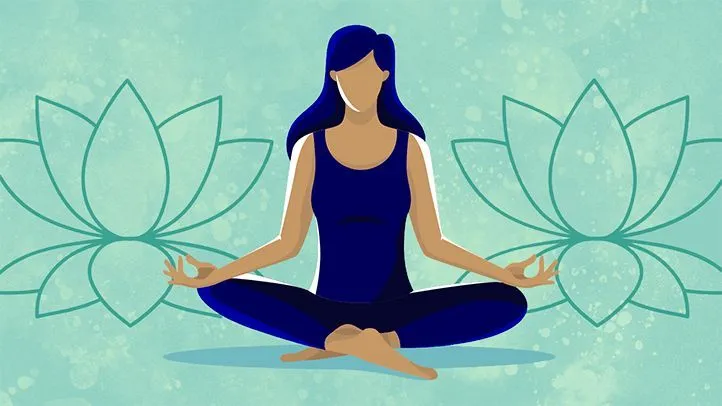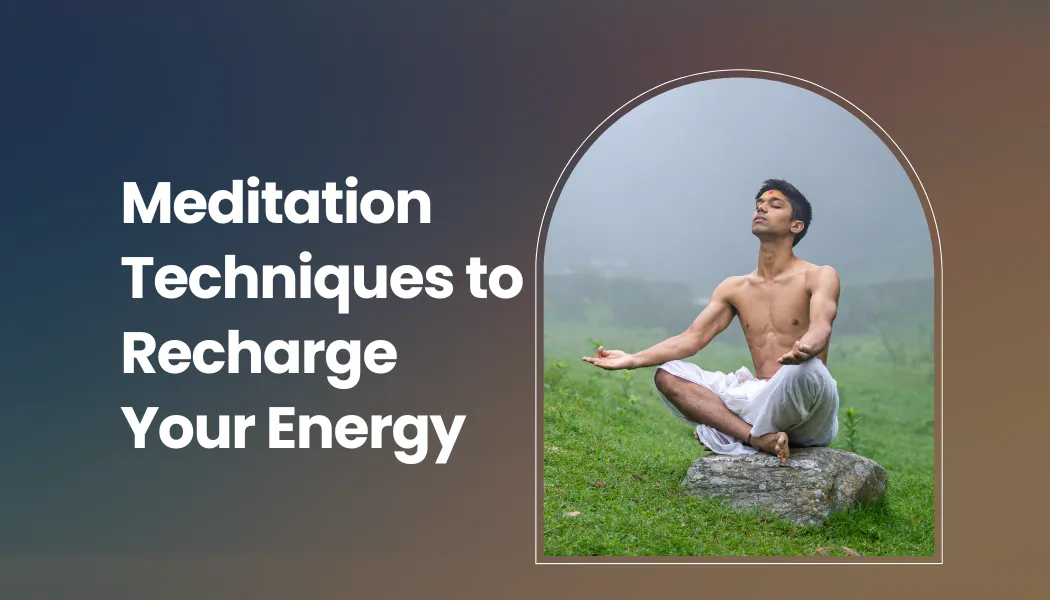In today’s fast-paced world, it’s easy to feel drained — physically, mentally, and emotionally. Long work hours, constant notifications, and high expectations leave many running on empty. While coffee and short breaks offer temporary relief, true sustained energy comes from within.
Meditation is a powerful tool to recharge your energy, restore balance, and sharpen focus. It works by calming the nervous system, regulating emotions, and aligning mind and body. Unlike passive rest, meditation actively replenishes your mental and physical reserves, leaving you more resilient, alert, and focused.
This article explores meditation techniques that boost energy, the science behind them, and practical ways to integrate them into daily life.
Table of contents
- 1. Understanding Energy in the Body
- 2. The Science Behind Meditation and Energy
- 3. Meditation vs. Napping: Why Meditation Wins
- 4. Preparation for Energy-Boosting Meditation
- 5. Meditation Techniques to Recharge Your Energy
- 6. Mindfulness Practices to Support Meditation
- 7. The Role of Meditation in Stress Management
- 8. Meditation and Sleep Energy Recharge
- 9. Meditation and Emotional Energy
- 10. Building a Daily Meditation Routine for Energy
- 11. Common Challenges and Solutions
- 12. Meditation for Professionals and Students
- 13. Meditation and Physical Health
- 14. Using Technology Mindfully for Meditation
- 15. Combining Meditation with Other Energy-Boosting Practices
- 16. The Long-Term Benefits of Meditation for Energy
- Conclusion: Recharge Your Life, One Breath at a Time
1. Understanding Energy in the Body
Energy isn’t just physical stamina; it encompasses mental clarity, emotional balance, and vitality. When energy is low, it manifests as:
- Mental fatigue or brain fog.
- Physical lethargy or muscle weakness.
- Emotional irritability or stress.
- Difficulty focusing or staying motivated.
Meditation helps restore energy by:
- Activating the parasympathetic nervous system, which promotes relaxation.
- Reducing stress hormones like cortisol, which drain energy.
- Improving circulation and oxygen flow to the brain and body.
- Releasing tension in muscles and calming racing thoughts.
2. The Science Behind Meditation and Energy
Research has shown that meditation affects the brain and body in ways that enhance energy levels:
a. Neurotransmitter Regulation
Meditation increases levels of serotonin, dopamine, and GABA — chemicals that regulate mood, motivation, and focus, contributing to sustained energy.
b. Cortisol Reduction
High cortisol levels from stress deplete physical and mental energy. Mindfulness and meditation lower cortisol, promoting relaxation and vitality.
c. Improved Sleep Quality
Regular meditation enhances sleep patterns, allowing deep restorative sleep, which directly impacts energy and alertness.
d. Enhanced Brain Function
Meditation strengthens prefrontal cortex activity, improving focus, decision-making, and executive function, all of which preserve mental energy.
e. Cardiovascular Benefits
Certain meditation techniques improve heart rate variability and circulation, increasing oxygen and nutrient delivery to muscles and organs, boosting overall vitality.
3. Meditation vs. Napping: Why Meditation Wins
While napping can provide temporary relief, meditation offers sustained energy by addressing both mind and body:
- Mental Reset: Meditation clears mental clutter, unlike naps, which only pause fatigue.
- Emotional Balance: Meditation reduces stress and anxiety, leaving you more energized emotionally.
- Quick Rejuvenation: Even 5–10 minutes of focused meditation can restore energy, whereas naps often require 20–90 minutes.
4. Preparation for Energy-Boosting Meditation
Before starting, create a conducive environment:
- Find a quiet space: Minimize distractions.
- Comfortable posture: Sit or lie down with a straight spine.
- Soft lighting or natural light: Avoid harsh lights.
- Optional props: Cushions, yoga mats, or blankets for comfort.
- Set an intention: Decide whether you want to recharge, focus, or release tension.
5. Meditation Techniques to Recharge Your Energy
Here are proven meditation techniques specifically designed to restore and enhance energy:
1. Breath of Energy Meditation (Pranayama)
Breathing deeply can activate the body’s energy flow and calm the mind.
Technique:
- Sit comfortably with a straight spine.
- Inhale deeply through your nose for 4 counts, filling the lungs completely.
- Hold the breath for 4 counts.
- Exhale slowly through your mouth for 6 counts.
- Repeat for 5–10 minutes, focusing on the breath’s rhythm.
Benefits:
- Boosts oxygen supply to the brain and muscles.
- Reduces fatigue and mental fog.
- Activates the parasympathetic nervous system for calm alertness.
2. Body Scan Meditation
This meditation releases physical tension that drains energy.
Technique:
- Lie down comfortably.
- Bring awareness to each part of your body, starting from the head down to your toes.
- Notice areas of tightness or discomfort without judgment.
- Breathe into those areas, imagining tension leaving your body with each exhale.
- Continue for 10–15 minutes.
Benefits:
- Relieves muscle tension.
- Increases body awareness.
- Replenishes energy by letting go of stored stress.
3. Visualization for Vitality
Visualization enhances mental and physical energy by engaging the mind’s creative focus.
Technique:
- Sit comfortably with eyes closed.
- Imagine a bright, energizing light filling your body from head to toe.
- Visualize it circulating through every organ and muscle.
- Feel warmth, strength, and vitality as you breathe deeply.
- Practice for 5–10 minutes.
Benefits:
- Strengthens the mind-body connection.
- Mentally prepares you for increased alertness and energy.
- Reduces mental fatigue and anxiety.
4. Mindful Movement Meditation (Qi Gong or Yoga Flow)
Movement-based meditation combines energy flow with mindfulness.
Technique:
- Perform slow, deliberate movements while focusing on breath and sensations.
- Examples: raising arms slowly while inhaling, lowering while exhaling; gentle spinal twists.
- Focus entirely on each movement.
- Practice 10–15 minutes.
Benefits:
- Enhances circulation and flexibility.
- Boosts physical energy.
- Reduces stress while grounding attention.
5. Loving-Kindness Meditation
Emotional energy is closely linked to physical vitality. Cultivating positive feelings boosts energy levels.
Technique:
- Sit comfortably and close your eyes.
- Repeat silently:
“May I be healthy. May I be strong. May I be energized.”
- Extend these wishes to others: friends, family, coworkers, and eventually all beings.
- Practice for 5–10 minutes.
Benefits:
- Increases positive emotions and resilience.
- Reduces emotional fatigue.
- Supports mental and emotional vitality.
6. Short Micro-Meditations for Busy Schedules
Even brief meditation sessions can recharge energy quickly.
Techniques:
- 1-Minute Breath Focus: Pause, close your eyes, and take three deep, conscious breaths.
- Desk Meditation: Focus on the sensation of your feet on the floor and your hands on the desk.
- Sensory Reset: Listen to sounds around you, notice textures, or feel the air on your skin for one minute.
Benefits:
- Provides instant mental reset.
- Restores focus and clarity.
- Can be used multiple times throughout the day for consistent energy boosts.
6. Mindfulness Practices to Support Meditation
Meditation works best when combined with mindful daily habits:
- Mindful Eating: Savor food slowly to boost digestion and energy absorption.
- Digital Detox: Limit notifications and screen time to prevent cognitive drain.
- Nature Walks: Observe surroundings with full attention, letting nature replenish mental energy.
- Gratitude Practice: Reflect on positive experiences to enhance emotional energy.
7. The Role of Meditation in Stress Management
Stress is a major energy drain. Meditation combats stress by:
- Lowering cortisol levels.
- Reducing sympathetic nervous system activity (fight or flight).
- Promoting parasympathetic activation (rest and digest).
- Increasing resilience against daily challenges.
By managing stress, meditation preserves energy for productive and fulfilling activities.
8. Meditation and Sleep Energy Recharge
Quality sleep is essential for energy. Meditation improves sleep by:
- Calming racing thoughts before bedtime.
- Promoting deeper, restorative sleep cycles.
- Reducing insomnia and restlessness.
A 10–15 minute meditation before bed can dramatically improve sleep quality and overall energy levels.
9. Meditation and Emotional Energy
Energy isn’t purely physical — emotions play a critical role. Meditation helps balance emotional energy by:
- Reducing anger, frustration, and anxiety.
- Cultivating patience, compassion, and optimism.
- Increasing motivation and enthusiasm for daily tasks.
Emotional vitality translates directly into physical and mental energy.
10. Building a Daily Meditation Routine for Energy
Consistency is key for long-term energy benefits. Here’s an example routine:
- Morning (5–10 min): Breath of Energy Meditation to start the day alert and energized.
- Midday (5 min): Micro-meditation or mindful walk to counter fatigue.
- Evening (10–15 min): Body Scan or Visualization to release tension and restore energy.
- Optional: Loving-Kindness meditation to recharge emotional energy.
Even short, consistent sessions produce cumulative energy benefits over time.
11. Common Challenges and Solutions
1. “I don’t have time.”
Start with 1–2 minutes. Micro-meditations are surprisingly effective.
2. “My mind keeps wandering.”
Mindfulness is about noticing wandering thoughts and gently returning to focus — this is progress, not failure.
3. “I feel sleepy instead of energized.”
Some meditation releases pent-up fatigue — it’s normal. With consistent practice, energy and alertness increase.
4. “I don’t feel results immediately.”
Benefits accumulate. Persistence and patience are essential.
12. Meditation for Professionals and Students
Meditation benefits anyone who needs sustained energy and mental clarity:
- Professionals: Maintains focus during long work hours and reduces burnout.
- Students: Enhances concentration, memory retention, and learning efficiency.
- Athletes: Speeds mental recovery, reduces fatigue, and improves performance.
- Creatives: Stimulates inspiration and reduces mental blockages.
Integrating meditation into daily routines leads to higher productivity and resilience.
13. Meditation and Physical Health
Physical energy is linked to overall health. Meditation supports:

- Cardiovascular health: Lower heart rate, blood pressure, and improved circulation.
- Immune function: Reduced stress supports stronger immunity.
- Pain management: Mindfulness meditation reduces perception of chronic pain and discomfort.
By strengthening the body-mind connection, meditation enhances vitality on multiple levels.
14. Using Technology Mindfully for Meditation
Meditation apps can guide practice without creating dependency:
- Timer apps: Set meditation duration without distractions.
- Guided sessions: Follow expert instructions for breath, body scan, or visualization.
- Mindful reminders: Gentle prompts to pause and recharge during the day.
The goal is energy replenishment, not digital fatigue.
15. Combining Meditation with Other Energy-Boosting Practices
For maximum benefit, combine meditation with:
- Hydration: Adequate water supports alertness.
- Nutrition: Balanced meals fuel mental and physical energy.
- Movement: Gentle stretching or yoga enhances circulation.
- Nature exposure: Sunlight and fresh air boost vitality.
Meditation becomes a catalyst, amplifying the benefits of healthy habits.
16. The Long-Term Benefits of Meditation for Energy
Consistent meditation offers profound, lasting benefits:
- Sustained mental and physical energy throughout the day.
- Enhanced focus, creativity, and problem-solving ability.
- Greater emotional resilience and reduced burnout.
- Improved sleep and recovery.
- Strengthened mind-body connection for holistic vitality.
Meditation is not just a temporary recharge — it’s a lifelong energy management tool.
Conclusion: Recharge Your Life, One Breath at a Time
Energy is the foundation of a productive, fulfilling life. While external factors like sleep, nutrition, and exercise play a role, true inner energy comes from mental and emotional balance. Meditation provides the tools to access this wellspring.
Whether it’s a deep breathing session, a body scan, or a short micro-meditation, each mindful moment recharges your mind, revitalizes your body, and restores emotional balance.
Start today, even for a few minutes, and notice the transformation. With regular practice, meditation becomes your personal power source — fueling focus, creativity, resilience, and joy.
The next time you feel drained, pause, breathe, and recharge from within. Your energy isn’t just restored — it’s amplified.
